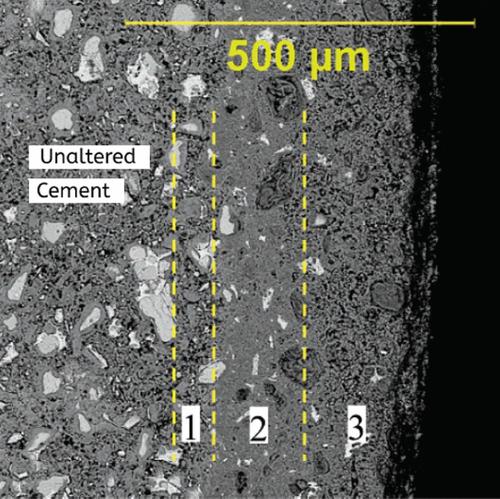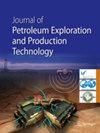A review of cement sheath integrity evaluation techniques for carbon dioxide storage
IF 3.2
4区 工程技术
Q3 ENERGY & FUELS
Journal of Petroleum Exploration and Production Technology
Pub Date : 2023-09-13
DOI:10.1007/s13202-023-01697-0
引用次数: 0
Abstract
Abstract Cement sheath integrity is a critical concern in the successful implementation of geologic carbon capture and storage (CCS) projects. Conventional ordinary Portland cement (OPC) is not thermodynamically compatible with the carbon dioxide (CO 2 ) present in CO 2 storage media. When OPC cement sheaths interact with aqueous CO 2 , they undergo degradation, producing calcium bicarbonate. This bicarbonate readily dissolves in the formation aquifer and can create leakage pathways, compromising the integrity of the wellbores. This study comprehensively reviews the state-of-the-art techniques for evaluating cement sheath integrity, providing a comprehensive compendium of available methods in a single article. The paper’s objective is to support the deployment of successful CCS projects, facilitate the remediation of affected wellbores in CO 2 storage systems, and offer guidelines for evaluating improved cement slurry designs and formulations. Additionally, the study identifies the factors that influence cement sheath integrity when exposed to aqueous CO 2 , including in-situ temperature and pressure, reservoir fluid characteristics, cement slurry formulations, and wellbore operations. Furthermore, various modes of mechanical failure in cement sheaths are identified, such as radial cracking, plastic deformation, inner and outer debonding, and channeling. Understanding these failure mechanisms is crucial for designing robust cementing strategies in CCS applications. Evaluation techniques for assessing the integrity of cement sheaths exposed to aqueous CO 2 encompass a range of approaches. These include direct experimentation with samples that mimic the in -situ conditions of storage sites, well logging for monitoring leakages, analytical, numerical, and statistical modeling, and risk assessments. Direct experimentation plays a vital role in understanding the carbonation kinetics and changes in cement sheaths' mechanical and transport properties. Techniques such as scanning electron microscopy, back-scattered electron image detectors, energy-dispersive spectroscopy, mercury intrusion porosimetry, optical microscopy, X-ray diffraction, electrical resistivity imaging, electron probe microanalyzers, inductivity-coupled plasma optical emission spectrometry, X-ray computed microtomography, Raman spectroscopy, direct image correlation, and particle velocimetry are utilized for direct experimentation. Analytical and numerical modeling approaches include reactive transport modeling, multi-scale modeling, computational fluid dynamics (CFD), and artificial intelligence (AI)-based modeling. In field operations, the integrity of the cement sheaths can be evaluated using cement bond evaluation tools, pressure transient test tools, cement coring tools, or sustained casing pressure analysis. These techniques collectively enable a comprehensive assessment of the integrity of cement sheath exposed to aqueous CO 2 , aiding in optimizing and monitoring carbon storage systems. Every CO 2 storage medium is unique. Optimal assessment of the cement sheaths' integrity of its wellbore systems, when exposed to aqueous CO 2 , would require a different combination of suitable evaluation techniques. Future studies should focus on developing standardized guidelines that combine laboratory testing, field-scale testing, and numerical modeling to predict the evolution of cement sheath integrity when exposed to aqueous CO 2 . Additional research is necessary to determine the optimal combinations of cement additives that enhance long-term resilience and resistance to carbonic acid attacks, enabling successful geologic sequestration. Furthermore, there are ample research opportunities to advance numerical modeling techniques for evaluating the effects of aqueous CO 2 on cement sheath integrity and identifying potential failure mechanisms.

二氧化碳封存水泥环完整性评价技术综述
水泥环完整性是成功实施地质碳捕集与封存(CCS)项目的关键问题。传统的普通硅酸盐水泥(OPC)与二氧化碳储存介质中存在的二氧化碳(CO 2)在热力学上不相容。当OPC水泥护套与水中的二氧化碳相互作用时,它们会发生降解,产生碳酸钙。这种碳酸氢盐很容易溶解在地层含水层中,并可能形成泄漏通道,损害井筒的完整性。本研究全面回顾了评估水泥环完整性的最新技术,在一篇文章中提供了可用方法的综合概述。本文的目的是支持CCS项目的成功部署,促进对二氧化碳储存系统中受影响的井眼的修复,并为评估改进的水泥浆设计和配方提供指导。此外,该研究还确定了当暴露于含水二氧化碳中时影响水泥环完整性的因素,包括现场温度和压力、油藏流体特性、水泥浆配方和井筒操作。此外,还确定了水泥护套的各种机械破坏模式,如径向开裂、塑性变形、内外剥离和沟槽。了解这些失效机制对于在CCS应用中设计稳健的固井策略至关重要。评估暴露于含水二氧化碳的水泥护套完整性的评估技术包括一系列方法。这些包括用模拟储存地点现场条件的样品进行直接实验,监测泄漏的测井,分析,数值和统计建模以及风险评估。直接实验对于理解水泥环碳化动力学以及水泥环力学和输运特性的变化具有至关重要的作用。直接实验采用扫描电子显微镜、背散射电子图像探测器、能量色散光谱、汞侵入孔隙法、光学显微镜、x射线衍射、电阻率成像、电子探针微分析仪、电感耦合等离子体光学发射光谱、x射线计算机显微断层扫描、拉曼光谱、直接图像相关、粒子速度测定等技术。分析和数值建模方法包括反应输运建模、多尺度建模、计算流体动力学(CFD)和基于人工智能(AI)的建模。在现场作业中,可以使用水泥胶结评估工具、压力瞬态测试工具、水泥取心工具或持续套管压力分析来评估水泥环的完整性。这些技术共同能够全面评估暴露于含水二氧化碳中的水泥环的完整性,有助于优化和监测碳储存系统。每种二氧化碳存储介质都是独一无二的。当暴露于含水的二氧化碳中时,对井眼系统的水泥环完整性进行最佳评估需要不同的评估技术组合。未来的研究应侧重于制定标准化的指导方针,将实验室测试、现场规模测试和数值模拟相结合,以预测暴露于含水二氧化碳时水泥环完整性的演变。需要进一步的研究来确定水泥添加剂的最佳组合,以提高长期弹性和抗碳酸侵蚀能力,从而实现成功的地质封存。此外,还有大量的研究机会来推进数值模拟技术,以评估含水二氧化碳对水泥环完整性的影响,并确定潜在的破坏机制。
本文章由计算机程序翻译,如有差异,请以英文原文为准。
求助全文
约1分钟内获得全文
求助全文
来源期刊
CiteScore
5.90
自引率
4.50%
发文量
151
审稿时长
13 weeks
期刊介绍:
The Journal of Petroleum Exploration and Production Technology is an international open access journal that publishes original and review articles as well as book reviews on leading edge studies in the field of petroleum engineering, petroleum geology and exploration geophysics and the implementation of related technologies to the development and management of oil and gas reservoirs from their discovery through their entire production cycle.
Focusing on:
Reservoir characterization and modeling
Unconventional oil and gas reservoirs
Geophysics: Acquisition and near surface
Geophysics Modeling and Imaging
Geophysics: Interpretation
Geophysics: Processing
Production Engineering
Formation Evaluation
Reservoir Management
Petroleum Geology
Enhanced Recovery
Geomechanics
Drilling
Completions
The Journal of Petroleum Exploration and Production Technology is committed to upholding the integrity of the scientific record. As a member of the Committee on Publication Ethics (COPE) the journal will follow the COPE guidelines on how to deal with potential acts of misconduct. Authors should refrain from misrepresenting research results which could damage the trust in the journal and ultimately the entire scientific endeavor. Maintaining integrity of the research and its presentation can be achieved by following the rules of good scientific practice as detailed here: https://www.springer.com/us/editorial-policies

 求助内容:
求助内容: 应助结果提醒方式:
应助结果提醒方式:


